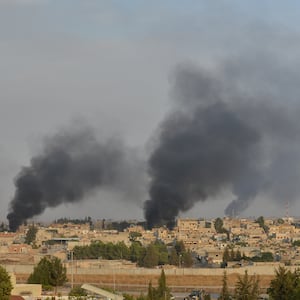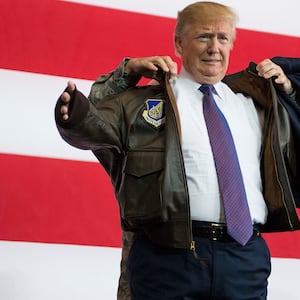To listen to President Donald Trump and his defenders, he’s ended a foolish and previously indefinite war in Syria. “We have no soldiers in the area, you know. We’re getting out of the endless wars. We have to do it,” Trump said Wednesday in the Oval Office. “We are out of there. We’ve been out of there for a while. No soldiers whatsoever.” He added on Thursday, “We have no soldiers in Syria.”
That is untrue.
Two knowledgeable U.S. officials confirmed to The Daily Beast that after a shocking week that has upended U.S. planning, the U.S. military has only pulled back from northern Syria, not pulled out. It’s abandoned two small observation posts in the area Turkey has now invaded. Around 50 service members have moved to a larger base, something both officials described as a force protection measure—protection amid the already bloody Turkish incursion, protection that no longer exists for the Kurdish force that the U.S. relied upon to assault the so-called Islamic State. None of the roughly 1,000 U.S. troops have actually left Syria since Trump’s fateful Sunday phone call with Recep Tayyip Erdogan.
ADVERTISEMENT
Instead, the U.S. military is currently in a holding pattern in Syria, one that many with experience in the endless wars that have ravaged a generation of Americans, Iraqis, Syrians and others consider a wrenching position. While actual withdrawal orders may yet come, for the beginning phase of Turkey’s attack on the Syrian Kurds, the Americans have ended no war, nor even their involvement in one. Instead, they’ve stood aside so their NATO ally can kill their anti-ISIS partner.
“I don’t know the tactical rationale for this,” said a former Pentagon official. “We’ve just exposed our partners. It’s a struggle for people of a ‘globalist,’ institutionalist [bent] – people who fought and bled with our partners – to understand.”
Multiple ex-Pentagon officials point out that the writing has been on the wall for the U.S. in Syria since December, when senior military officers and their civilian counterparts in the administration and Congress convinced Trump to delay his pullout. That was what caused Defense Secretary Jim Mattis and State Department anti-ISIS chief Brett McGurk to resign from the administration. In his June confirmation hearing, the new chairman of the Joint Chiefs of Staff, Army Gen. Mark Milley, told senators that only “a modest amount of [military] capability” remained necessary in Syria.
But the writing on the wall has yet to materialize in actual orders to bring the troops home. It fits the pattern that Trump has set throughout his presidency: talking about ending the wars but falling short of actually ending any. More typically, he’s instead escalated the endless wars he inherited, in terms of both money and violence. In Syria, Trump has upended plans from the summer that appeared to forestall a Turkish invasion against the Kurds by jointly establishing and patrolling a “safe zone” from which Kurdish forces pulled back.
“We thought it was a good compromise outcome,” a senior State Department official told reporters on Thursday.
Now, according to a U.S. official, the military is observing the carnage with its drones and other surveillance aircraft overhead. Ostensibly, service members are watching to see if and how ISIS will exploit Turkey’s invasion. What they will do in the event of an ISIS offensive is anything but clear.
Aside from that, the U.S. in Syria is in the process of taking custody of ISIS detainees that the Syrian Democratic Forces have held and, with Turkey pursuing them, no longer prioritize. But out of 11,000 held, the U.S. is moving only 50 so-called high value detainees to its facilities in Iraq. Doing so creates a legal complication. The longer they are held without charge, the greater the likelihood they can challenge the basis for their detention in U.S. federal court, and potentially prompt a judge’s ruling that the congressionally-undeclared war is illegal. Trump, in his Oval Office remarks, shrugged at the idea of a mass ISIS prisoner release, on the notion that “they're going to be escaping to Europe. That's where they want to go.”
Top State Department officials briefing reporters on Thursday opted to insist that both the troop pullback and a White House invitation to Erdogan next month – one Trump announced on Twitter with the hashtag “#endendlesswars” – was a “very clear red light” for the Turkish invasion. One senior official claimed the troop pullback occurred because the observation posts did not comprise a “defens[ive] force,” rather than a signal to Erdogan that he could do as he pleased.
The senior department official said that the invasion “endangers our allies in the fight against terror,” but demurred when asked if the U.S. “condemn[ed]” the invasion, calling it instead a “very bad idea.” The official warned Turkey against “inhumane” or “disproportionate” violence in northeastern Syria, and said examples of such that might trigger sanctions from Washington were “ethnic cleansing” or “indiscriminate artillery, air or other fires directed at the civilian population.” While the official noted the invasion is in its early days, “we have not seen significant examples of that so far.”
The goal of the U.S. is now, the senior State Department official said, finding a path to a negotiated settlement out of the war. “We have very important work to do with the SDF,” the official said. Whether the SDF believes it still has important work to do with the United States that stood back as the Turks attacked them remains to be seen.







